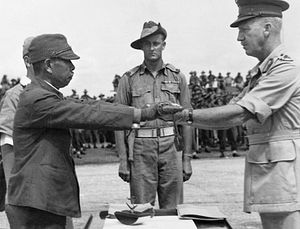The American contribution notwithstanding, the War in the Pacific didn’t begin on December 7, 1941, and didn’t end in August 1945. Much as with Europe, the fighting continued across the expanse of the continent, and deep into the Pacific, for years after the formal Japanese surrender. The end of hostilities between Japan and the United States represents one of the most important milestone in the larger, lengthier struggle over the decolonization of East Asia, but only one. The wars-of-continuation would decide the fates of Vietnam, China, Korea, Indonesia, and much of the rest of the Asia-Pacific.
In Korea, Soviet forces advanced into the northern part of the peninsula in the autumn of 1945, allowing Kim Il-sung to take power in Pyongyang. In the south, American client Syngman Rhee succeeded the Japanese occupation authority. Fighting ensued almost immediately, and continued at varying levels of escalation until the North Korean invasion of June 1950. That invasion, triggering U.S. and eventually Chinese intervention, would lead to a formal status quo which left two sovereign states in control of the peninsula.
In Indonesia, Japanese Army administrators allowed Republican activists to declare independence shortly after the Japanese surrender to the United States. British forces took responsibility for management of the archipelago in the intermediate aftermath of the war, often in consultation with remaining Japanese troops. The Dutch, believing that they could retake control of the archipelago, dispatched naval, ground, and air forces, and raised local levies to fight. Following a brutal four year conflict, the Dutch finally evacuated Indonesia and recognized the government of Sukarno in December, 1949. The Indonesian state continues to struggle to control the territory that the Dutch left behind.
In Vietnam, the Viet Minh quickly seized control of the north as the Japanese Army surrendered. Chinese Nationalist occupation forces arrived, and began the process of preparing the country for a return of the French. Negotiations between the Viet Minh and the French faltered, resulting in a ten-year war that split Vietnam in half, secured independent states for Cambodia and Laos, and set the stage for another war that would last 20 years before the reunification of Vietnam under a Communist banner in 1975.
But the biggest conflict came in China, where Nationalist and Communist forces restarted a fight that had begun in 1927. Nationalist forces had suffered badly from the war against Japan, but nevertheless had conventional advantages against the Communists. The PLA, however, had built a secure base in rural areas, and eventually (with Soviet help) succeeded in defeating Nationalist forces and rolling up all of China. Surviving Nationalist forces escaped to Formosa (Taiwan).
Smaller conflicts raged in Malaya, the Philippines, and elsewhere, not to mention the convulsions that seized the Indian subcontinent. Thus, the map of East Asia continues to display the scars of World War II. The existence of two Koreas and two Chinas stems directly from the unfinished conflicts of the Second World War, as did the war that resulted in the unification of Vietnam.
In this context, it’s hardly surprising that the wounds of World War II remain so vivid in East Asia; the war lasted a very long time, and ended only recently.

































